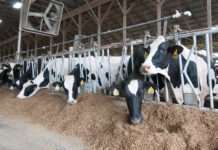MANHATTAN, Kan. – The Kansas Department of Agriculture has completed surveillance and testing in Leavenworth and Wyandotte counties and lifted movement restrictions for the quarantined area. Movement of live poultry and poultry products, including eggs, can resume as normal.
KDA officials surveyed and tested every poultry premise within the infected zone, multiple premises in the buffer zone and responded to seven sick bird calls. All test results were found to be negative.
“We appreciate the citizens that self-reported their flocks. It has allowed us to effectively identify the number of flocks in the area and ensure we stamped out this virus,” said Dr. Justin Smith, Kansas Deputy Animal Health Commissioner. “We could not have responded as quickly as we did without the great support of both county emergency management coordinators as well as the fantastic facilities provided by the Fairmount Township Fire Station.”
Avian Influenza is a contagious, rapidly spreading viral disease affecting birds. Outbreaks of a strain of avian influenza have occurred in Missouri, Arkansas, Minnesota, Oregon, South Dakota, Washington and Idaho and are not considered to be a threat to public health or the food supply.
Avian Influenza exists naturally in many wild birds and can be transmitted by contact with infected animals or ingestion of infected food or water. The Center for Disease Control considers the risk to people from these HPAI H5 infections in wild birds, backyard flocks and commercial poultry, to be low. No human infections with the virus have been detected at this time.
Kansas Animal Health Commissioner Dr. Bill Brown encourages all poultry owners to continue to closely monitor their flocks and contact their local veterinarian immediately if birds appear infected. For a listing of symptoms of HPAI, visit www.agriculture.ks.gov/avianinfluenza.com.
Farmers and ranchers can protect their flocks with good biosecurity practices including:
- Isolate new animals
- Move all livestock away from boundaries of your property
- Clean clothing and boots should be worn when contact with livestock is expected.
- Thoroughly clean and disinfect equipment and animal areas
- Monitor your animals for signs of the disease



